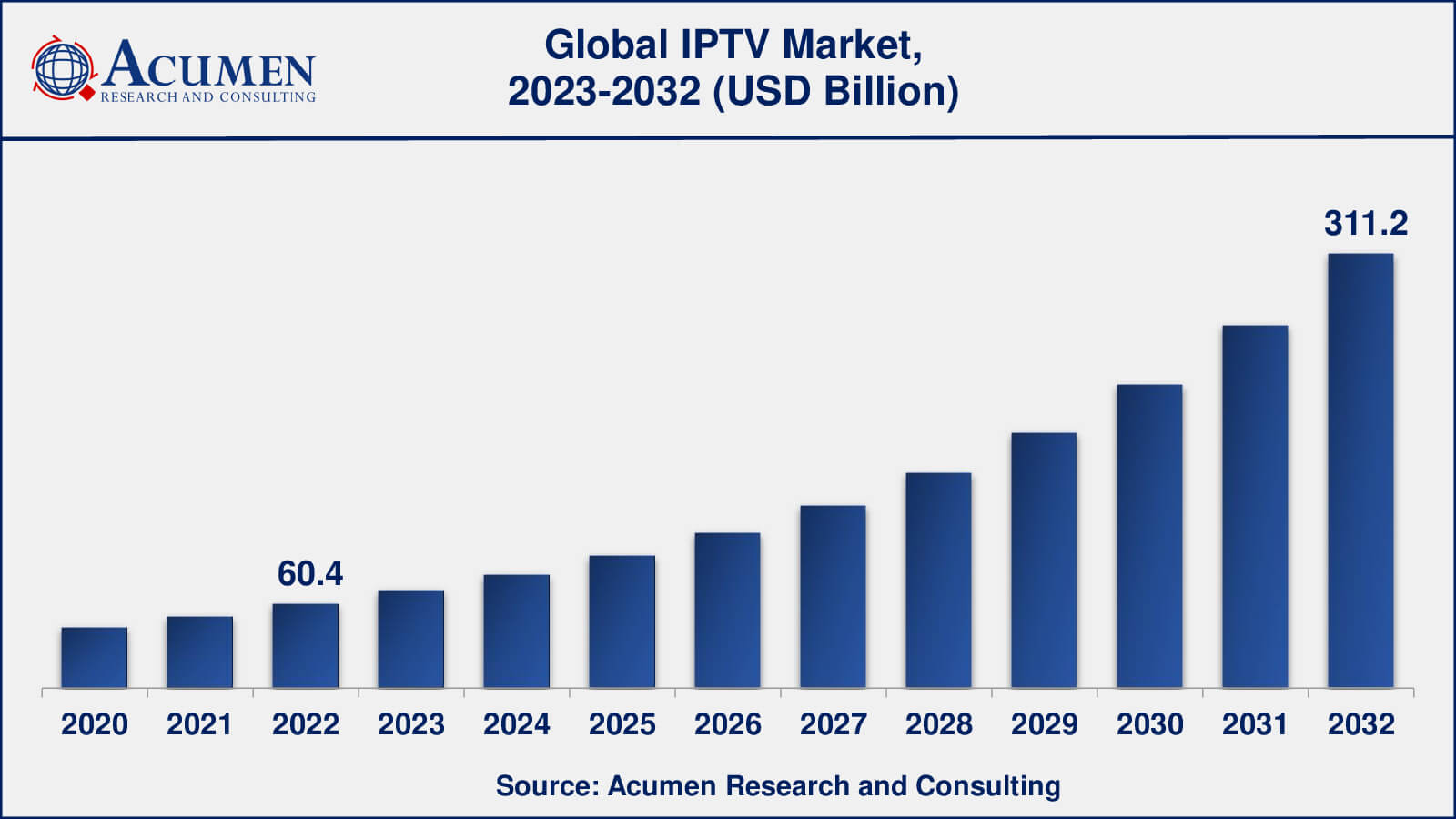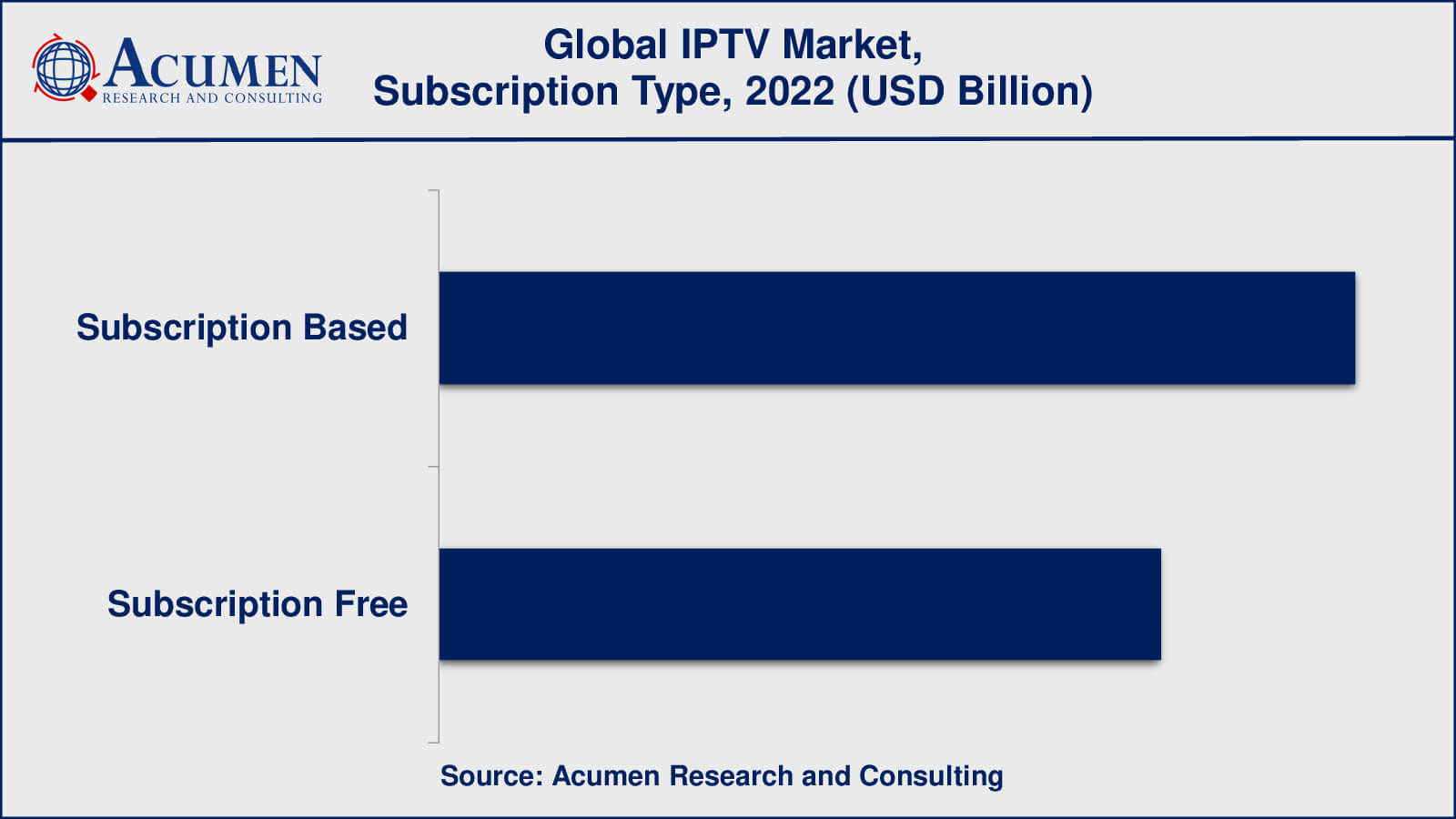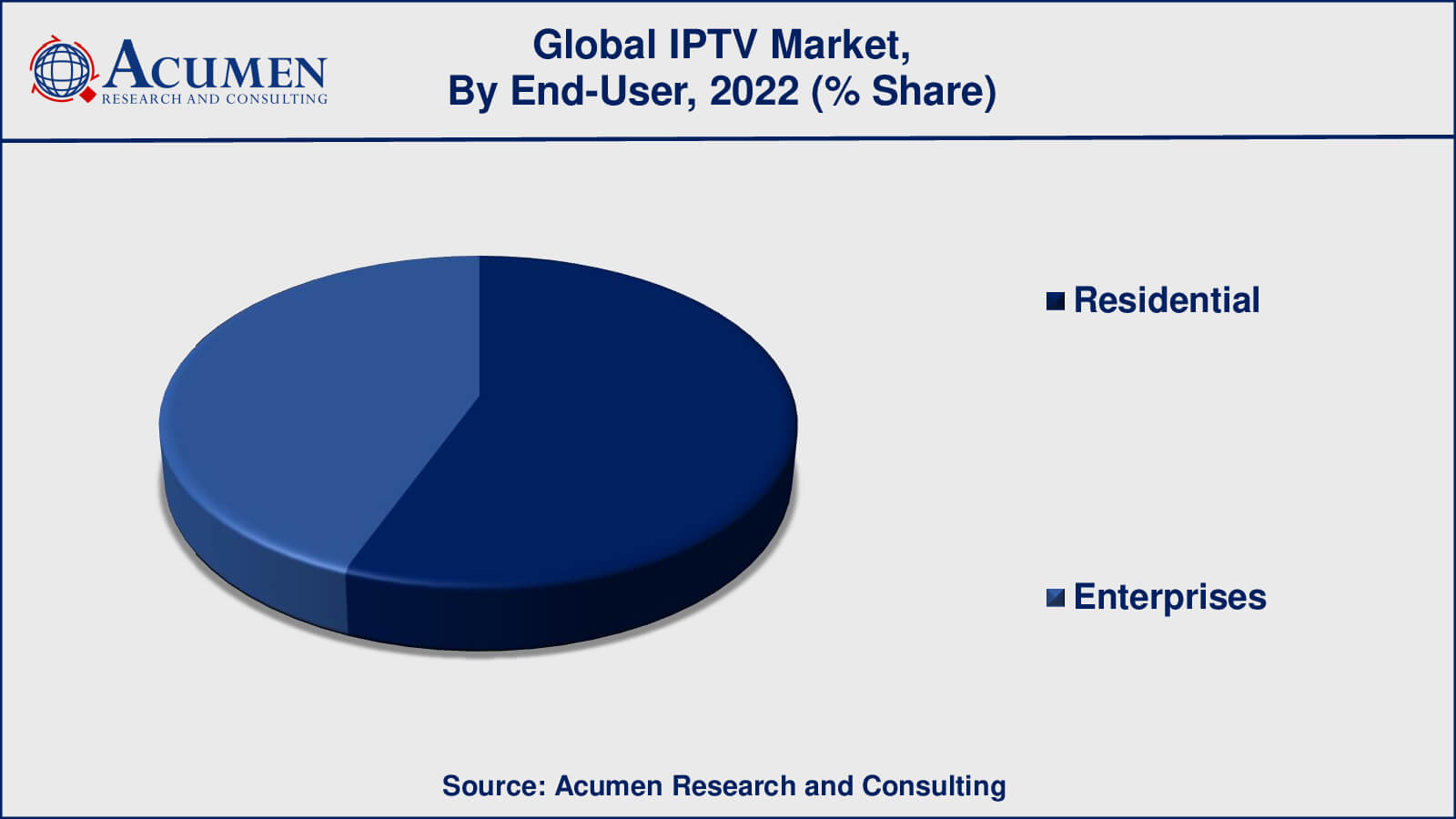July 2023
IPTV Market Size collected USD 60.4 Billion in 2022 and is set to achieve a market size of USD 311.2 Billion in 2032 growing at a CAGR of 16.1% from 2023 to 2032.
The Global IPTV Market Size collected USD 60.4 Billion in 2022 and is set to achieve a market size of USD 311.2 Billion in 2032 growing at a CAGR of 16.1% from 2023 to 2032.
IPTV Market Report Statistics

As long as any user has control over the high-speed Internet and has a device that supports IP such as a laptop, smartphone, or tablet, he can avail the IPTV or Internet protocol television service regardless of where he is or what time it is. The network providers have experienced requirements for advance networking systems as the users of HD videos and VoD (video on demand) are increasing abruptly. Hence, telecommunication, multimedia, and network research players have intensely developed IPTV technology. IPTV can broadcast live TV signals to any IP-supported devices as mentioned above like tablets and smartphones with the support of high-speed Internet connectivity and other broadband service providers. Also, it supports companies of telecommunication who are seeking a chance to increase their profits not only with data and voice services but also with IPTV. Instead of using the traditional way of delivering Internet services like cable, satellite signal, etc. IPTV uses logical Internet protocol to deliver its television content.
IPTV offers services to buffer the media in smaller packets, directly from its source, with the help of media players that can play the media even before the entire data has been delivered. There are mainly three classifications of IPTV services viz., live television, time-shifted television, and video on demand. Live television can or cannot be related to the current TV shows, time-shifted television is playing a media that was broadcasted in past (an hour or a few days ago) and video on demand where users can browse through the catalog of media which is irrelevant of TV programming.

Global IPTV Market Dynamics
Market Drivers
Market Restraints
Market Opportunities
IPTV Market Report Coverage
| Market | Internet Protocol Television Market |
| Internet Protocol Television Market Size 2022 | USD 60.4 Billion |
| Internet Protocol Television Market Forecast 2032 | USD 311.2 Billion |
| Internet Protocol Television Market CAGR During 2023 - 2032 | 16.1% |
| Internet Protocol Television Market Analysis Period | 2020 - 2032 |
| Internet Protocol Television Market Base Year | 2022 |
| Internet Protocol Television Market Forecast Data | 2023 - 2032 |
| Segments Covered | By Transmission Method, By Device Type, By Offering, By Subscription Type, By Application, By End-User, And By Geography |
| Regional Scope | North America, Europe, Asia Pacific, Latin America, and Middle East & Africa |
| Key Companies Profiled | AT&T Inc., Deutsche Telecom AG, Cisco Systems, Inc., China telecom Corporation Ltd., Huawei Technologies Co., Ltd., NTT Communication, Iliad S.A., Century Link, and Verizon Communication. |
| Report Coverage |
Market Trends, Drivers, Restraints, Competitive Analysis, Player Profiling, Covid-19 Analysis, Regulation Analysis |
Internet Protocol Television IPTV Market Growth Factors
The rise in the number of Internet service providers is the major reason behind the growing demand for Internet video advertising. However, network congestion and distorted Internet speeds is the major challenge faced by this industry. The IPTV market is facing high opportunities for growth due to growing demand for high-quality video content and online catalog, hence the main focus of service providers is currently on improving content quality, and increasing the speed of delivery and performance of the website. Customers are only concerned about the media being delivered to them as and when required, they have no concern about the process behind the IPTV CDN. The unrelenting demand for mobile data is also one of the factors responsible for the growth of the IPTV industry. The abrupt increase in data traffic caused by several smart devices has played a major role in the increase in demand for Wi-Fi devices. The growth in demand of the IPTV industry is also led by several other factors such as the availability of HD channels, hybrid services, and video-on-demand. The common problem faced by the IPTV market includes the lack of infrastructure to offer services that are free from problems like jitter. Regions like MENA have very little local premium products, and because of this most of the shows are produced out of this region. These kinds of operators will require high investment to secure their content, which will require high involvement. This would result in an increase in cost and pose a challenge to the service provider. Also, the problems of piracy and the protection of content would be the key challenge for these service providers and operators.

Internet Protocol Television (IPTV) Market Segmentation
The worldwide market for IPTV is categorized based on transmission method, device type, offering, subscription type, application, end-user, and geography.
IPTV Transmission Method Outlook
According to the IPTV market forecast, the wired transmission is expected to gather largest share. While wireless transmission has grown in popularity in recent years, thanks to the proliferation of mobile devices and 5G networks, wired transmission remains the most dependable and widely used method for delivering IPTV services. Because wired networks, such as fiber optic and cable networks, provide more bandwidth and more stable connections than wireless networks, they are more popular. Furthermore, wired networks are better suited to delivering high-quality video content, which is an important feature of IPTV services. As a result, wired transmission methods remain dominant in the IPTV market, especially among developed nations with advanced telecommunications infrastructure.
IPTV Device Type Outlook
Smart TVs are currently dominating the largest IPTV market share in terms of device type. This is because smart TVs are specifically designed to provide a better streaming experience, allowing users to access IPTV services directly from their TV sets. Many smart TVs include built-in IPTV apps as well as support for popular streaming services, allowing consumers a simpler way to access and watch their preferred content. Furthermore, smart TVs are becoming more affordable, which is propelling their adoption in both advanced and emerging economies. While smartphones, tablets, and PCs all have a significant share of the IPTV industry, smart TVs are a popular choice for users who chose a more traditional TV viewing experience due to their convenience and large screen size.
IPTV Deployment Offering Outlook
The bundled offering segment controls the majority of the IPTV industry. This is due to the fact that bundled IPTV services are frequently offered as part of a larger package that includes other telecommunications services such as broadband internet and phone services. Bundled offerings can save customers money if they subscribe to multiple services, which is an appealing feature for many users. Furthermore, bundled offerings are frequently marketed as part of a "triple play" or "quad play" package that includes IPTV, broadband internet, telephone, and occasionally mobile services, making them a convenient option for customers looking to consolidate their telecommunications services. Standalone offerings, on the other hand, are frequently more expensive and aimed at users who only want IPTV services and no other telecommunications services. While standalone IPTV services have a significant market share, bundled offerings currently hold the majority of the IPTV market share.
IPTV Subscription Type Outlook

The subscription-based segment controls the majority of the IPTV market. This is because subscription-based IPTV services provide service providers with a consistent and reliable revenue stream, allowing them to invest in better technology, content offerings, and customer support. Subscription-based services typically provide more premium features and content, such as live TV channels, video-on-demand, and personalized recommendations, which appeal to users willing to pay for a better viewing experience. Furthermore, subscription-based services frequently have stronger security measures in place to combat piracy and protect their content. While subscription-free services like ad-supported and free-to-air IPTV are popular, they have a smaller market share than subscription-based services.
IPTV Application Outlook
According to the IPTV industry analysis, the non-linear TV application has gathered the utmost shares in the IPTV market. Non-linear TV, also known as video-on-demand (VOD), enables users to access video content on demand, giving them greater control over what and when they watch. Non-linear TV applications include Netflix, Amazon Prime Video, Hulu, and other streaming services that provide users with on-demand access to a vast library of content, including movies, TV shows, and original content. Because of their convenience and flexibility, non-linear TV applications have grown in popularity, allowing users to watch content on their own time and without the constraints of traditional linear TV broadcasting. While linear TV continues to account for a sizable portion of the IPTV market, the trend towards non-linear TV is anticipated to continue in the coming years as more users seek on-demand content and personalized viewing experiences.
IPTV End-User Industry Outlook

The residential end-user industry controls a sizable portion of the IPTV market. This is due to the fact that IPTV services are primarily targeted at residential customers, who use the service to access a variety of TV channels and on-demand content from the comfort of their own homes. Residential customers represent a sizable and expanding market for IPTV service providers, especially as demand for high-quality video content and streaming services grows. Furthermore, IPTV services are becoming more affordable and accessible, which is increasing their popularity among residential customers. While the enterprise market is important in the IPTV market, it is more niche and focused on specific industries and use cases, such as corporate training and communication, rather than mass-market adoption.
IPTV Market Regional Outlook
North America
Europe
Asia-Pacific
Latin America
The Middle East & Africa
IPTV Market Regional Analysis
North America is a significant market for IPTV services, with the United States and Canada leading the way. The high adoption of advanced technologies in these countries, as well as the presence of established telecommunication infrastructure, is the primary drivers behind the development of the IPTV market in this region.
Europe is also a significant market for IPTV services, with major contributors including the United Kingdom, France, Germany, and Spain. The high penetration of smartphones, smart TVs, and other connected devices, as well as the growing demand for high-quality video content, are driving the growth of the IPTV market in this region.
The Asia Pacific region is projected to become the largest market for IPTV services, with major contributors including China, India, and Japan. The high population density, rising disposable income, and rising demand for high-quality video content are contributing to the expansion of the IPTV market in this region.
Internet Protocol Television (IPTV) Market Players
Some of the global IPTV companies profiled in the report include AT&T Inc., Deutsche Telecom AG, Cisco Systems, Inc., China telecom Corporation Ltd., Huawei Technologies Co., Ltd., NTT Communication, Iliad S.A., Century Link, and Verizon Communication.
Looking for discounts, bulk pricing, or custom solutions? Contact us today at sales@acumenresearchandconsulting.com
July 2023
November 2020
November 2023
December 2020